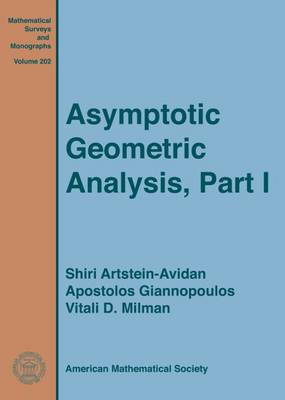Mathematical Surveys and Monographs
3 total works
Asymptotic Geometric Analysis, Part I
by Shiri Artstein-Avidan, Apostolos Giannopoulos, and Vitali D. Milman
Published 30 July 2015
The authors present the theory of asymptotic geometric analysis, a field which lies on the border between geometry and functional analysis. In this field, isometric problems that are typical for geometry in low dimensions are substituted by an ``isomorphic'' point of view, and an asymptotic approach (as dimension tends to infinity) is introduced. Geometry and analysis meet here in a non-trivial way. Basic examples of geometric inequalities in isomorphic form which are encountered in the book are the ``isomorphic isoperimetric inequalities'' which led to the discovery of the ``concentration phenomenon'', one of the most powerful tools of the theory, responsible for many counterintuitive results.
A central theme in this book is the interaction of randomness and pattern. At first glance, life in high dimension seems to mean the existence of multiple ``possibilities'', so one may expect an increase in the diversity and complexity as dimension increases. However, the concentration of measure and effects caused by convexity show that this diversity is compensated and order and patterns are created for arbitrary convex bodies in the mixture caused by high dimensionality.
The book is intended for graduate students and researchers who want to learn about this exciting subject. Among the topics covered in the book are convexity, concentration phenomena, covering numbers, Dvoretzky-type theorems, volume distribution in convex bodies, and more.
A central theme in this book is the interaction of randomness and pattern. At first glance, life in high dimension seems to mean the existence of multiple ``possibilities'', so one may expect an increase in the diversity and complexity as dimension increases. However, the concentration of measure and effects caused by convexity show that this diversity is compensated and order and patterns are created for arbitrary convex bodies in the mixture caused by high dimensionality.
The book is intended for graduate students and researchers who want to learn about this exciting subject. Among the topics covered in the book are convexity, concentration phenomena, covering numbers, Dvoretzky-type theorems, volume distribution in convex bodies, and more.
Geometry of Isotropic Convex Bodies
by Silouanos Brazitikos, Apostolos Giannopoulos, Petros Valettas, and Beatrice-Helen Vritsiou
Published 1 February 2014
The study of high-dimensional convex bodies from a geometric and analytic point of view, with an emphasis on the dependence of various parameters on the dimension stands at the intersection of classical convex geometry and the local theory of Banach spaces. It is also closely linked to many other fields, such as probability theory, partial differential equations, Riemannian geometry, harmonic analysis and combinatorics. It is now understood that the convexity assumption forces most of the volume of a high-dimensional convex body to be concentrated in some canonical way and the main question is whether, under some natural normalisation, the answer to many fundamental questions should be independent of the dimension.
The aim of this book is to introduce a number of well-known questions regarding the distribution of volume in high-dimensional convex bodies, which are exactly of this nature: among them are the slicing problem, the thin-shell conjecture and the Kannan-Lovasz-Simonovits conjecture. This book provides a self-contained and up to date account of the progress that has been made in the last fifteen years.
The aim of this book is to introduce a number of well-known questions regarding the distribution of volume in high-dimensional convex bodies, which are exactly of this nature: among them are the slicing problem, the thin-shell conjecture and the Kannan-Lovasz-Simonovits conjecture. This book provides a self-contained and up to date account of the progress that has been made in the last fifteen years.
Asymptotic Geometric Analysis, Part II
by Shiri Artstein-Avidan, Apostolos Giannopoulos, and Vitali D. Milman
Published 28 February 2022
This book is a continuation of Asymptotic Geometric Analysis, Part I, which was published as volume 202 in this series.
Asymptotic geometric analysis studies properties of geometric objects, such as normed spaces, convex bodies, or convex functions, when the dimensions of these objects increase to infinity. The asymptotic approach reveals many very novel phenomena which influence other fields in mathematics, especially where a large data set is of main concern, or a number of parameters which becomes uncontrollably large. One of the important features of this new theory is in developing tools which allow studying high parametric families.
Among the topics covered in the book are measure concentration, isoperimetric constants of log-concave measures, thin-shell estimates, stochastic localization, the geometry of Gaussian measures, volume inequalities for convex bodies, local theory of Banach spaces, type and cotype, the Banach-Mazur compactum, symmetrizations, restricted invertibility, and functional versions of geometric notions and inequalities.
Asymptotic geometric analysis studies properties of geometric objects, such as normed spaces, convex bodies, or convex functions, when the dimensions of these objects increase to infinity. The asymptotic approach reveals many very novel phenomena which influence other fields in mathematics, especially where a large data set is of main concern, or a number of parameters which becomes uncontrollably large. One of the important features of this new theory is in developing tools which allow studying high parametric families.
Among the topics covered in the book are measure concentration, isoperimetric constants of log-concave measures, thin-shell estimates, stochastic localization, the geometry of Gaussian measures, volume inequalities for convex bodies, local theory of Banach spaces, type and cotype, the Banach-Mazur compactum, symmetrizations, restricted invertibility, and functional versions of geometric notions and inequalities.


